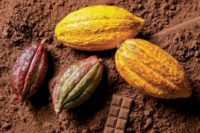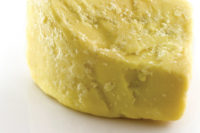
Photo courtesy of Cargill
Filling cocoa butter's shoes
If it looks like cocoa butter, acts like cocoa butter and tastes like cocoa butter, then it probably is cocoa butter. Or is it? The growing use of Cocoa Butter Alternatives might make it hard to tell.Traditionally acting as the only vegetable fat in chocolate products, cocoa butter gives chocolate its texture, sharp melting behavior, high gloss, long shelf life and good flavor release characteristics, states Fuji Oil Europe, a producer of oils and fats for the chocolate and confectionery industry, on its web site. But cocoa butter comes with a price.
Cocoa butter can be incompatible with other fat systems and has a limited melting profile, says Adam Lechter, product services and development manager, ADM Cocoa. It can also be costly and, unlike some Cocoa Butter Alternatives, it must be tempered. Although they are just stand-ins for cocoa butter, Cocoa Butter Alternatives can lend some flexibility to chocolate products.
“By using these different Cocoa Butter Alternatives, you can develop coatings with higher melt points, higher bloom resistance and specific functionalities as in, you can tell them to be for either moulding or enrobing,” says Ed Wilson, v.p. sales and marketing, AarhusKarlshamn (AAK) USA, Inc.
But what are Cocoa Butter Alternatives, or CBAs, in the first place? Cocoa Butter Alternatives consist of three categories: Cocoa Butter Substitutes (CBSs), Cocoa Butter Replacers (CBRs) and Cocoa Butter Equivalents (CBEs).
Cocoa Butter Substitutes (CBSs)
“Cocoa Butter Substitutes are typically fractionated and partially hydrogenated lauric fat compounds with steep melting profiles resulting in a mouth feel and texture more similar to cocoa butter,” says Rick Schwartz, director of technical services, Cargill Cocoa & Chocolate. But as he points out, “They are not compatible with cocoa butter.”The raw materials for CBSs generally consist of lauric products such as palm kernel and coconut oil, says Wilson, AAK USA.
“The benefits of Cocoa Butter Substitutes are that they melt down and give flavor release equal to that of pure cocoa butter,” Wilson says. “They also are very easy handling, meaning they crystallize rapidly in a stable form, [have] good gloss and good bloom stability.”
But there’s also a downside to the substitutes.
“The drawback is that CBS-based coatings can only tolerate up to 5% max of any other fat, which includes milk fat, which you get from milk powder; cocoa butter, which you get from cocoa powder; or any other fat you would want to put into it,” he explains.
Using any more than 5% may create a eutectic in the coating, he adds, which can lower the melting point of the chocolate.

Photo courtesy of ADM
Cocoa Butter Replacers (CBRs)
Similar to CBSs, Cocoa Butter Replacers will not have any added cocoa butter, however, their tolerance to other fats is up to 20%. This allows the use of chocolate liquor as an ingredient, which contains more cocoa butter than cocoa powder does. CBRs’ raw materials generally consist of non-lauric products such as soybean, cottonseed and palm oils, Wilson says.Additionally, CBRs should not be tempered, says Lechter, ADM Cocoa, which may help to simplify the production process.
Cocoa Butter Equivalents (CBEs)
The last segment of the CBA category, Cocoa Butter Equivalents, is the closest to cocoa butter in its nutritional profile.“Cocoa Butter Equivalents have similar handling properties of cocoa butter and must be tempered,” says Schwartz, Cargill Cocoa & Chocolate. “They are usually a mixture of palm and shea oil and have a similar fatty acid profile to cocoa butter.”
“With CBEs, there is no limitation on the amount of fats you can use,” explains Wilson, AAK USA.

Photo courtesy of AAK USA
Pricing and labeling
Overall, besides cost, the main reasons for using CBAs versus cocoa butter are ease of processing, greater fat compatibility and a diversity of melting profiles, says Lechter, ADM Cocoa.“In today’s markets … a typical CBS could be $0.60 a pound; a typical CBR could be $0.85 a pound; and a typical CBE could be $1.40 a pound, with today cocoa butter being approximately $3 a pound,” explains Wilson, AAK USA. “Cost is generally the first parameter used to look at when looking at a CBA.”
And although CBAs can help reduce costs, in the United States, the product cannot be called “chocolate” if any CBA is used. The products must then use terminology such as “chocolatey” or “chocolate flavored.”
But these labeling limitations do not exist all over the world. The European Union, for example, allows products to contain up to 5% of CBEs with additional restrictions on cocoa solids and milk fat percentages, Wilson says.
And even though CBAs most likely won’t appear in “pure chocolate” products in the United States anytime soon, that doesn’t mean companies aren’t using them.
Most chocolate companies in the United States continue to market their core brands using only cocoa butter; however, Wilson foresees the continual growth of CBEs in products that do not use chocolate as a primary ingredient (such as cookies, nuts, pretzels or wafers).
Tim Surin, marketing manager- North America, Loders Croklaan agrees, adding, “as the economy continues to put pressure on manufacturers, it is expected that Cocoa Butter Equivalent use could increase as manufacturers learn how to integrate this technology into their product portfolios in order to remain competitive and offer lower cost products to the market.”
Because cocoa butter is the gold standard for confectionery, CBAs have some pretty big shoes to fill. And while CBSs, CBRs and CBEs are all notably “alternatives” to cocoa butter, each category brings something beneficial to the table.
Note: For more information about specific Cocoa Butter Alternatives available for confectionery, visitwww.candyindustry.comand click onCandy Industry Plus.


